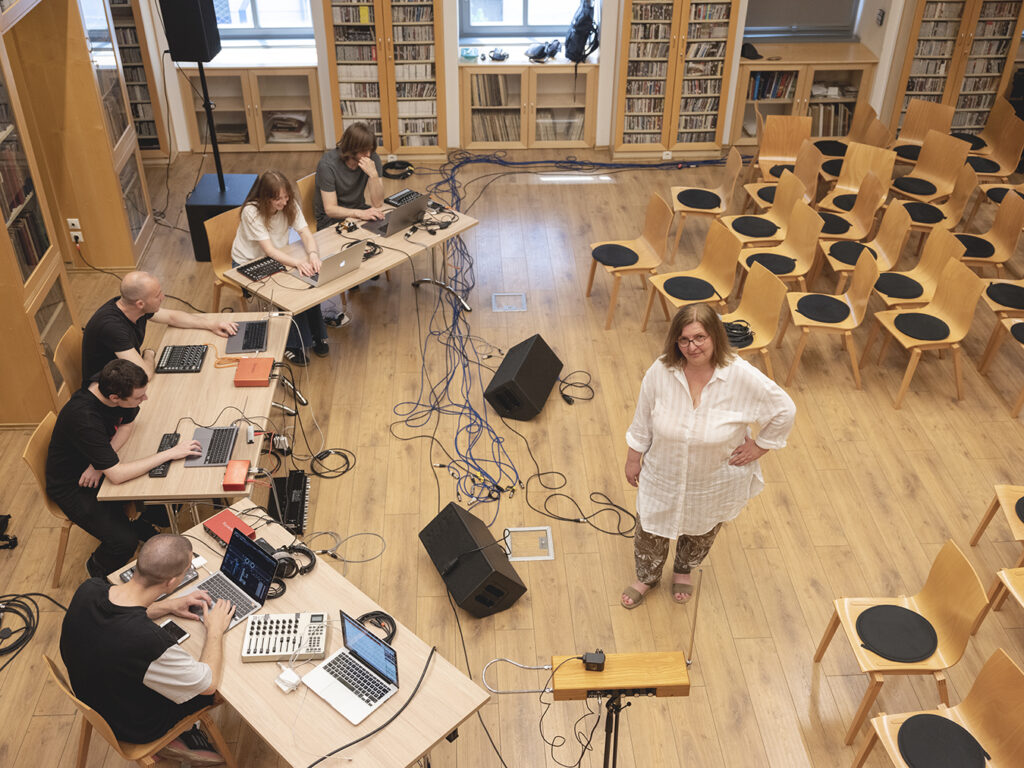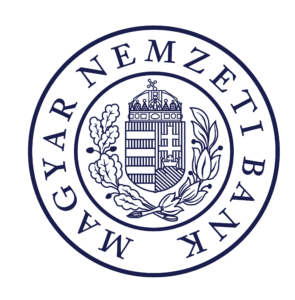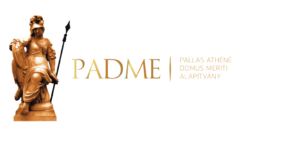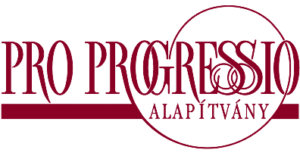In her capacity as a composer and as a teacher, Andrea Szigetvári joined the residency programme to research the relationship between music and technology while she is also paving the way for new cooperation opportunities between the two universities.
What motivated you to participate in the art residency programme, and what are the greatest challenges for you?
I’d say the greatest challenge is the topic itself. I think artificial intelligence is gaining importance, and it is here to stay in the field of music, too. I have also started to deal with AI, it’s gaining prominence in the applications that I work with where large bodies of data need to be handled. What motivates me most is that I can work together with colleagues at the Technical University who conduct research in this field and now we have the opportunity to collaborate. It seems a greatly interesting task to examine the relationship between artificial intelligence and music. We need to learn how to use new programmes, in fact, we often don’t know where to start, what the most pressing questions are and, at the end of the day, you have to create a new work of art. That is the greatest challenge.
How do you think technology can be exploited to extend the possibilities of musical creativity and performance?
For instance, by doing things we have not been able to do before. For me, applying technology means to broaden our minds, our abilities, our musical resources and go down on so far unbeaten paths in the realm of music. My major interest is looking at the composition potentials of timbre which is a tough nut to crack, because as opposed to pitch (low or high pitch), which has one dimension, timbre has several dimensions and an infinite range. With the opening up of a theoretically infinite sound field (of timbres), it becomes necessary to structure and interpret a vast and unexplored area, which is impossible to survey and manage without computers. Until now, we have been attempting to systematically catalogue various timbres with analogue means, but these efforts were fraught with difficulties. Today we have such an abundance of data that we cannot move ahead without computers, so I think there is plenty of room for development in this respect.
Your name is often associated with the term “timbre solfége”. Could you explain to the lay reader what this means?
I studied electronic music and music arrangement/direction at the Frederyk Chopin Academy of Music in Warsaw. Here, we had a subject called timbre solfége. Solfége is the study of pitch, rhythm, and the relationship between sounds, and it is also about learning musical terminology. Timbre solfége is basically the same thing, but you do not focus on pitches and rhythm but on various timbre. A sound editor, for example, has to be able to handle the filter function on the mixing table by means of which timbres can also be adjusted. They usually acquire their skills on the basis of experience; they need to test all these filter settings to know what timbre they can expect to hear. We, at the academy, had to learn how the editing frequencies of individual filters would sound, in exactly the same way as we have to be able to hear that the distance between two sounds, and say, for instance, that this is a major third. When I started to teach electronic music in Hungary, it occurred to me that this method could be extended to all other techniques involving timbres. At the academy of music, we teach how it is possible to set the parameters for sound synthesis and sound transition techniques. Our task is to classify, recognise and remember these timbres.
During your career, you have been to many countries as a guest teacher and as a composer. What sort of experience have you collected at the international scene? How can you make use of this experience at home?
The most important journey I have had so far was to the USA; with the help of a Soros-scholarship. I was a guest researcher at the Brooklyn University in New York, and then later at Stanford University. Both universities boasted a very high standard computerised studio, and the things I picked up there broadened my horizons so much that very often I still fall back on those experiences. Back then, computers in Hungary were only few and far between, so when I arrived in the USA, the world opened up for me by getting access to tools that were simply not available at home at that time. The same thing can be said for the time I spent at the ZKM (Centre for Art and Media) in Karlsruhe. They had a concert hall even back then which boasted a dome-shaped sound technology, so I had 42 loudspeakers above me arranged in a semicircle and it was possible to arrange programmes for this special setting in the soundscape. Now we have a sound dome in Hungary, too, but in order to gain knowledge about these, and to understand what new technologies we need, we must be familiar with state-of-the-art developments already achieved abroad. I am lucky to get first-hand information from several colleagues who inform me about new findings in research, education and composition. Because this is a constantly developing area, one cannot stop, one needs keep on learning and creating new things. In order to do it, we need ongoing discussions with our colleagues abroad, and personal meetings are also absolutely indispensable.
Currently, you teach electroacoustic music at the Ferenc Liszt Academy of Music as an associate professor, and you also have classes at the Media Design and Animation programme at the Budapest Metropolitan University (METU).
At METU, I only teach in the Animation programme, and I used to teach at the Media Design programme but not anymore. I am really interested in the combination of sound and image, so teaching in these two programmes is a great challenge for me and I do indeed learn a lot of new things. These activities are also very important for me.
What relationships can you identify between the two artistic fields you mentioned?
Audiovisual art is a genre where music and motion picture are combined and generate new meaning, new interpretations. This phenomenon also has to do with biology: if we hear a sound and see some image at the same time, we find it hard to believe that the two are not connected. For example, if I can see a door being shut on screen, and I hear a string of the double bass struck at the same time, even if I do not actually hear the sound of the shutting of the door, I will still be under the impression that one event was the consequence of the other – that is, that sound was made as a result of the door being shut. The two impressions complement each other in a way that a third entity is created when they appear together, but which are not present when I only hear the sound or look at the image independently. These audiovisual phenomena interest me a great deal. And, as far as teaching at two universities is concerned, I think it is really helpful, because this provides me with ample opportunities to devise collaboration schemes between the students of the two universities. We have a lot of projects where they are both involved; i.e. when there is an animation project prepared by the students at METU, and the accompanying sound design is made by the students of the academy of music. Such cooperation schemes can open new horizons, and help these students build and extend their networks on the one hand, and they can see for themselves how they combine their work with other fields, on the other hand.
Are you predominantly a composer, and teaching comes second, or is it the other way round? How do you manage to practise these professions at the same level?
It is hard to tell. I had never thought that I would ever teach. When I returned from Warsaw, I started to work as a researcher at the Institute of Musicology; I was a member of the Experimental Musicology working group. Some time later I started to work as a tutor at the International Bartók Festival in Szombathely where I met a lot of international colleagues. Then I was asked to teach at the University of Pécs, and later also at the Academy of Music in Budapest. As I mentioned earlier, this area is an ever-progressing one, so for me to be able to teach, I need to keep abreastf the latest achievements, so being able to teach presupposes a lot of previous learning. I also get a lot of new inspirations from the talented young people I meet at the university, and working with them is always a wonderful experience. More often than not, I learn new things from them, and not the other way round. What I like about teaching is that these students can be easily motivated to learn independently; they will bring novelties into the classroom and, at the end of the day, we will be able to work together almost as colleagues. Going back to your question as to whether I am a teacher first, and a composer or researcher second, I cannot tell; I feel I am all three at the same time, and this best works if my students feel the same way.
In your application to the art residency programme, one of your objectives was to foster active mutual cooperation between the teachers and students of BME and those of the Ferenc Liszt Academy of Music. How do you envisage this collaboration in practice?
My work of art, realised within the framework of the programme, will be a collaboration of different stakeholders; some will be responsible for collecting sounds, others will be adjusting them, and another group of people will be producing them. Copyright law has an essential role in this process as well, because in putting together the work we would like to keep the background information of the various sound files, brought in by different contributors, as metadata (i.e. the name of the composers) and it should be identifiable who contributed with what in this collaborative work. We organise workshops where such encounters – I hope – can take place.

Composer Andrea Szigetvári teaches at the Ferenc Liszt Academy of Music, and deals with electric and electroacoustic music. She has extensive international experience and is also involved in the Hungarian experimental music scene. One essential endeavour for her, both as an artist and as a researcher, is to incorporate technology into the creative process of composing music. Her portrait is available at this link:
Orsolya Demjén
pictures: László Belicza


